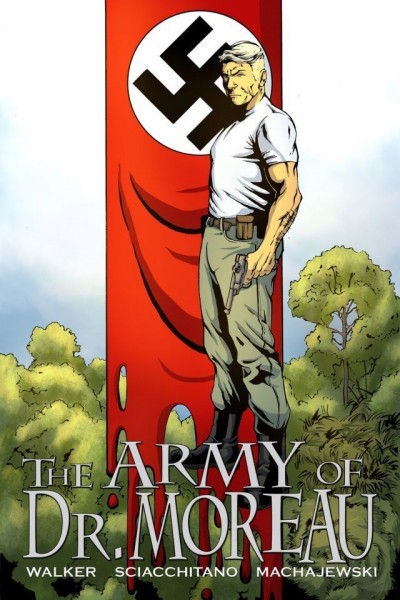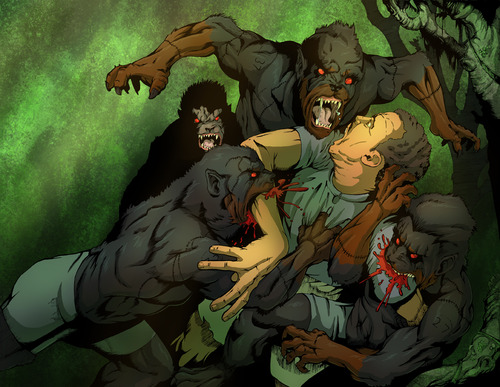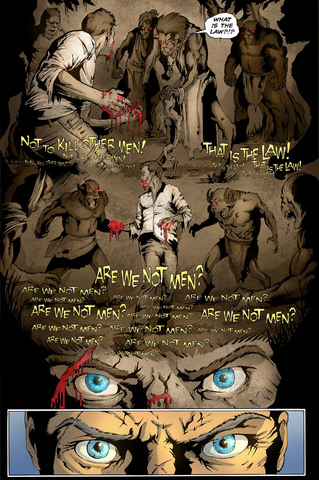The Army of Dr. Moreau #2 Review: A Steady Build
When I last reviewed
The Army of Dr. Moreau, I was very excited about the series and what was to come. Not much has changed in that regard; I’m still excited, still eager. The first issue gave us some truly bone chilling antagonists; the protagonist (or protagonists), however, weren’t quite as memorable. There’s still plenty of time for that, but I’d like to spend much of this still positive review exploring the characters in this story, and if any have the potential to emerge as a hero or heroes.

The
Army of Dr. Moreau #2 is mostly a transitional issue. While plenty does indeed happen, most of it is a build up towards what’s to come. The most significant occurrence in issue #2 would have to be the introduction of a new enclave of characters: descendants of Moreau’s subjects, his “monsters,” who are unfortunately caught in the middle of the Nazis’ plot to recreate the now infamous Doctor’s eugenic experiments.
The most interesting character that, at this stage, can be considered one of the “good guys,” is Edward Prentiss, the weathered “soldier of fortune” as he describes himself, who still has nightmares about Moreau’s Island and its unique inhabitants. His face riddled with scars, his dreams are flashbacks to what it is that scarred him, the monsters who chant in groups, “ARE WE NOT MEN?” In these dreams, Prentiss is fighting for his life as a significantly younger man. Now, he’s returning to the place that he seems to have never left, the place that has haunted him deep into his older years.
The government agents who have brought Prentiss along are still skeptical about whether or not Moreau is, in fact, real, despite having intercepted near-unmistakable German correspondences pertaining to “creature soldiers.” Similarly, they had enough initial evidence to put this whole expedition together. Still, and not necessarily without justification, Prentiss is looked at as a bit of a—well—a lunatic. I’m excited to see how his role and influence will change once it’s discovered just how right he is.

And for what is often a very graphic comic book, what are supposed to be descendants of Moreau’s “monsters”—the “enclave” I discussed earlier—look a bit more like ThunderCats, complete with human musculature and facial expressions. In short, they look too friendly—that is, even though they are clearly intended to be. Some of the “monsters” look fierce, while the others I’m now describing look like cartoons. I was actually somewhat surprised when I saw them. They just didn’t seem to fit.
Despite this minor discrepancy, I’m a huge fan of the artwork in
The Army of Dr. Moreau. Carl Sciacchitano manages to capture the time period excellently. Frequently tasked with depicting gore, he manages to make it appear every bit as disturbing as it truly is. There are moments when Prentiss is waking from his nightmares, and the panel depicts a close up of his eyes as a younger man. The next panel, then, is the same close up, but of old Prentiss. Young Prentiss’ fresh cuts and lacerations match up with old Prentiss’ scars, and the effect is fantastic. Sciacchitano, in short, has given these characters a life that only an artist could.
--that is, of course, not to take away from David F. Walker’s contributions. As I mentioned earlier, the pacing is excellent. Walker has set in motion a story that could just as easily build towards conflict on a global scale as towards one that doesn’t so much as leave the island. The introduction of the descendants of Moreau’s “monsters”—for lack of a better term—is brilliant. I wouldn’t have thought to make them “good.”

Overall, I’m excited about this story’s direction. Edward Prentiss is the likeliest candidate for growth—the “I told you so” after it was already too late character. Then again, I could be way off. That’s the beauty of storytelling; expectations don’t always pan out.
Pros
- Well paced story development
- Finely detailed panels
- Striking and effective color work
- Introduces interesting characters
Cons
- Relatively uneventful (not overly so)
 The Army of Dr. Moreau #2 is mostly a transitional issue. While plenty does indeed happen, most of it is a build up towards what’s to come. The most significant occurrence in issue #2 would have to be the introduction of a new enclave of characters: descendants of Moreau’s subjects, his “monsters,” who are unfortunately caught in the middle of the Nazis’ plot to recreate the now infamous Doctor’s eugenic experiments.
The most interesting character that, at this stage, can be considered one of the “good guys,” is Edward Prentiss, the weathered “soldier of fortune” as he describes himself, who still has nightmares about Moreau’s Island and its unique inhabitants. His face riddled with scars, his dreams are flashbacks to what it is that scarred him, the monsters who chant in groups, “ARE WE NOT MEN?” In these dreams, Prentiss is fighting for his life as a significantly younger man. Now, he’s returning to the place that he seems to have never left, the place that has haunted him deep into his older years.
The government agents who have brought Prentiss along are still skeptical about whether or not Moreau is, in fact, real, despite having intercepted near-unmistakable German correspondences pertaining to “creature soldiers.” Similarly, they had enough initial evidence to put this whole expedition together. Still, and not necessarily without justification, Prentiss is looked at as a bit of a—well—a lunatic. I’m excited to see how his role and influence will change once it’s discovered just how right he is.
The Army of Dr. Moreau #2 is mostly a transitional issue. While plenty does indeed happen, most of it is a build up towards what’s to come. The most significant occurrence in issue #2 would have to be the introduction of a new enclave of characters: descendants of Moreau’s subjects, his “monsters,” who are unfortunately caught in the middle of the Nazis’ plot to recreate the now infamous Doctor’s eugenic experiments.
The most interesting character that, at this stage, can be considered one of the “good guys,” is Edward Prentiss, the weathered “soldier of fortune” as he describes himself, who still has nightmares about Moreau’s Island and its unique inhabitants. His face riddled with scars, his dreams are flashbacks to what it is that scarred him, the monsters who chant in groups, “ARE WE NOT MEN?” In these dreams, Prentiss is fighting for his life as a significantly younger man. Now, he’s returning to the place that he seems to have never left, the place that has haunted him deep into his older years.
The government agents who have brought Prentiss along are still skeptical about whether or not Moreau is, in fact, real, despite having intercepted near-unmistakable German correspondences pertaining to “creature soldiers.” Similarly, they had enough initial evidence to put this whole expedition together. Still, and not necessarily without justification, Prentiss is looked at as a bit of a—well—a lunatic. I’m excited to see how his role and influence will change once it’s discovered just how right he is.
 And for what is often a very graphic comic book, what are supposed to be descendants of Moreau’s “monsters”—the “enclave” I discussed earlier—look a bit more like ThunderCats, complete with human musculature and facial expressions. In short, they look too friendly—that is, even though they are clearly intended to be. Some of the “monsters” look fierce, while the others I’m now describing look like cartoons. I was actually somewhat surprised when I saw them. They just didn’t seem to fit.
Despite this minor discrepancy, I’m a huge fan of the artwork in The Army of Dr. Moreau. Carl Sciacchitano manages to capture the time period excellently. Frequently tasked with depicting gore, he manages to make it appear every bit as disturbing as it truly is. There are moments when Prentiss is waking from his nightmares, and the panel depicts a close up of his eyes as a younger man. The next panel, then, is the same close up, but of old Prentiss. Young Prentiss’ fresh cuts and lacerations match up with old Prentiss’ scars, and the effect is fantastic. Sciacchitano, in short, has given these characters a life that only an artist could.
--that is, of course, not to take away from David F. Walker’s contributions. As I mentioned earlier, the pacing is excellent. Walker has set in motion a story that could just as easily build towards conflict on a global scale as towards one that doesn’t so much as leave the island. The introduction of the descendants of Moreau’s “monsters”—for lack of a better term—is brilliant. I wouldn’t have thought to make them “good.”
And for what is often a very graphic comic book, what are supposed to be descendants of Moreau’s “monsters”—the “enclave” I discussed earlier—look a bit more like ThunderCats, complete with human musculature and facial expressions. In short, they look too friendly—that is, even though they are clearly intended to be. Some of the “monsters” look fierce, while the others I’m now describing look like cartoons. I was actually somewhat surprised when I saw them. They just didn’t seem to fit.
Despite this minor discrepancy, I’m a huge fan of the artwork in The Army of Dr. Moreau. Carl Sciacchitano manages to capture the time period excellently. Frequently tasked with depicting gore, he manages to make it appear every bit as disturbing as it truly is. There are moments when Prentiss is waking from his nightmares, and the panel depicts a close up of his eyes as a younger man. The next panel, then, is the same close up, but of old Prentiss. Young Prentiss’ fresh cuts and lacerations match up with old Prentiss’ scars, and the effect is fantastic. Sciacchitano, in short, has given these characters a life that only an artist could.
--that is, of course, not to take away from David F. Walker’s contributions. As I mentioned earlier, the pacing is excellent. Walker has set in motion a story that could just as easily build towards conflict on a global scale as towards one that doesn’t so much as leave the island. The introduction of the descendants of Moreau’s “monsters”—for lack of a better term—is brilliant. I wouldn’t have thought to make them “good.”
 Overall, I’m excited about this story’s direction. Edward Prentiss is the likeliest candidate for growth—the “I told you so” after it was already too late character. Then again, I could be way off. That’s the beauty of storytelling; expectations don’t always pan out.
Overall, I’m excited about this story’s direction. Edward Prentiss is the likeliest candidate for growth—the “I told you so” after it was already too late character. Then again, I could be way off. That’s the beauty of storytelling; expectations don’t always pan out.